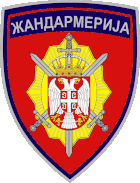|
Gendarmery (Serbia)
The Gendarmery (Serbian: Жандармерија, romanized: Žandarmerija) is the national gendarmerie force of Serbia, tasked with high-risk and specialized law enforcement duties. It is under the authority of the Police Directorate of the Serbian Police.[2] History The word žandarmerija is a French loanword ("gendarmerie"), and is pronounced "zhandarmeriya". The Žandarmerija corps date back to the Principality of Serbia, established on June 28, 1860, and originally consisted of 120 infantrymen and 15 cavalrymen. From 15 to 17 June 1862, the Serbian Gendarmerie played a crucial role in the conflicts around the Čukur fountain in Belgrade - a little more than 100 gendarmes opposed a Turkish force several hundred times stronger and practically saved Belgrade and Serbia. The 1884 Law on the Gendarmerie established the State Gendarmerie which was organized into detachments with one detachment in Belgrade and every district town. In 1919, the Gendarmerie became an integral part of the Royal Army of the Kingdom of Yugoslavia, tasked for watching over public order and security, maintaining order and peace and ensuring the execution of the laws. The Gendarmerie was subordinated to the Minister of Military Affairs in terms of supply, discipline and military training, and in terms of use, training, maintenance of public security and gendarmerie service - to the Ministry of the Internal Affairs. After World War II gendarmery was disbanded only to be re-established more than half a century later, in 2001, after the disbandment of the Special Police Units (Posebna Jedinica Policije, PJP).[1] One of its first major assignments of newly-formed Gendarmery was the capture of the suspects in the assassination of Prime Minister Zoran Đinđić. That same year, the Counter-Terrorist Unit was established within Gendarmery, but was separated in 2007 to become an independent unit within the Police.[3] In 2005 the Persons and Infrastructure Protection Unit was established, to carry out close protection and technical protection tasks.[3][1] In 2011 the Gendarmery was reorganized and the First Quick Response Detachment was established, consisting of the specialist companies of all Gendarmery detachments along with the Diving Center.[3] MissionsThe Gendarmery's missions include:
It may also perform any duties decreed in the laws and regulations. StructureGendarmery is organized in four "detachments" (odredi), battalion-size units, each with their own territorial jurisdiction (based in Belgrade, Novi Sad, Niš, and Kraljevo).[1] Detachment is organized as independent unit in order to be able to execute every-day duties on its territory of jurisdiction although, if needed, can provide assistance to other detachments as well.[4] The structure of the detachment is as follows: 
In addition to the detachments deployed throughout the country, the Gendarmery has one specialized unit: the Diving Unit of the Gendarmery (Ronilačka jedinica Žandarmerije), headquartered in Belgrade.[1] It is tasked with conducting special actions in water-dominated environments and consists of three specialist teams: intervention team, searching team and nautical team.[3] Equipment       The following equipment is in operational use as of 2024: Firearms
VehiclesMotor Vehicles
Armored Vehicles
Watercraft
CommandersSince its re-establishment in 2001, the Gendarmery has had eight Commanders:[1]
TraditionsAnniversaryThe anniversary is celebrated on 28 June, in memory of the day in 1860 when the Gendarmery was established. Patron saintThe unit's slava or its saint's feast day is Vidovdan (Saint Vitus). See alsoReferences
External linksWikimedia Commons has media related to Gendarmerie (Serbia).
|
||||||||||||||||||||||||||||
